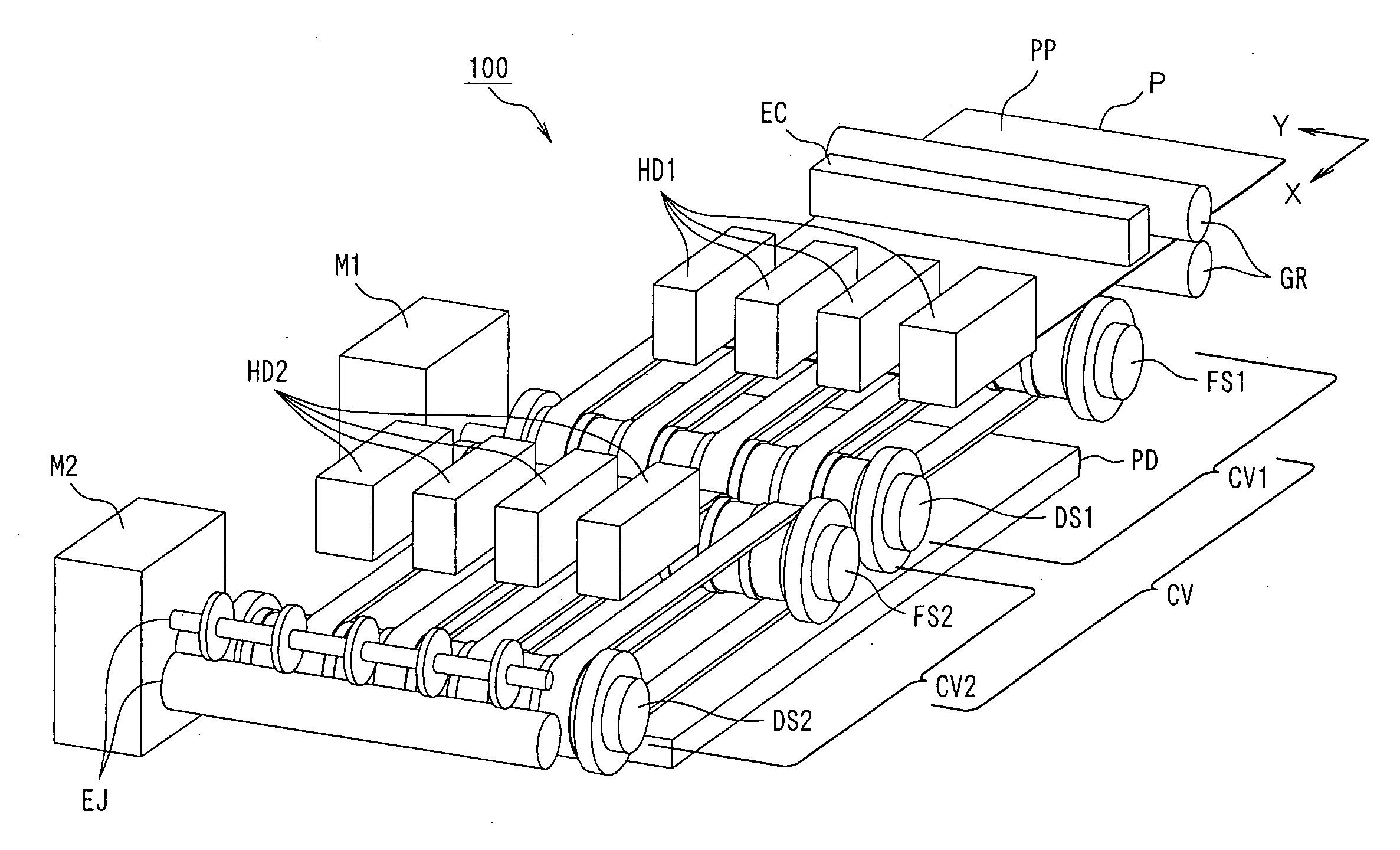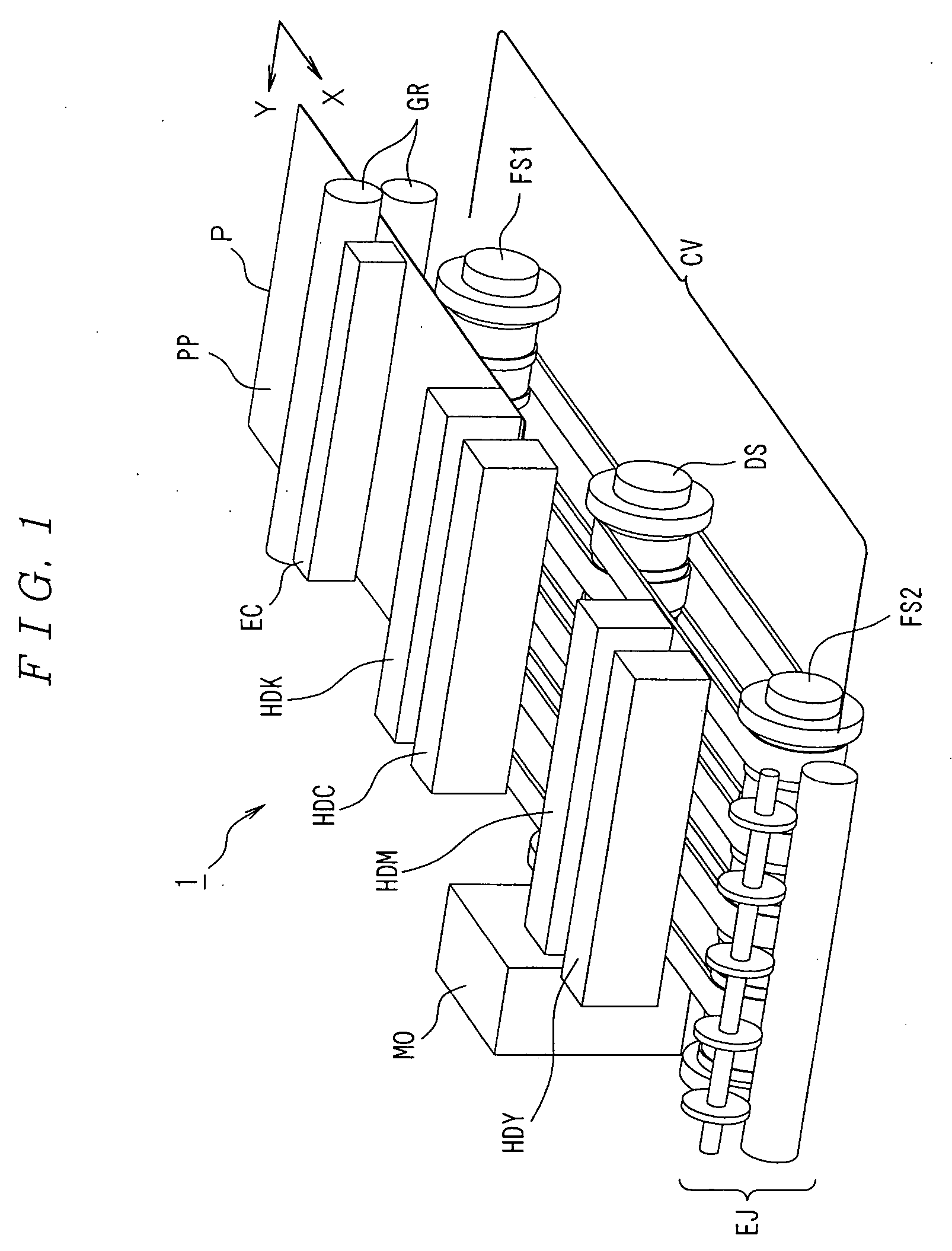Ink jet printer
a jet printer and ink technology, applied in the direction of printing, thin material processing, article separation, etc., can solve the problems of deterioration of the performance of discharging ink drips from the nozzle, rising of the viscosity of the ink in the nozzle, and the inability to discharge ink drips
- Summary
- Abstract
- Description
- Claims
- Application Information
AI Technical Summary
Benefits of technology
Problems solved by technology
Method used
Image
Examples
first embodiment
[0158] the present invention is described below by referring to the accompanying drawings.
[0159] As shown in FIG. 1, the ink jet printer 1 of the first embodiment has a gate roller GR, an static electricity supply portion EC, sheet conveying portion CV, yellow, magenta, cyan, and black printing heads HDY, HDM, HDC, and HDK for discharging various colors of ink drips of yellow, magenta, cyan, and black, and sheet ejecting portion EJ.
[0160] Details of the above configurations are described below.
[0161] As shown in FIG. 2 which is a top view, the sheet conveying portion CV has a driving shaft DS to which motive power is transferred from a conveying-portion driving motor M0, first and second driven shafts FS1 and FS2 parallel with the driving shaft DS and located at mutually opposite sides at both sides of the driving shaft DS, a first conveying belt V1 applied to the driving shaft DS and the first driven shaft FS1, a second conveying belt V2 applied to the driving shaft DS and the se...
second embodiment
[0218] the present invention is described below by referring to the accompanying drawings.
[0219] As shown in FIG. 11, the ink jet printer 100 of the second embodiment has the same configuration as the first embodiment except that a sheet conveying portion CV is constituted by including a first conveying portion CV1, and a second conveying portion CV2 to be driven independently from the first conveying portion CV1, a printing head is constituted of a first printing head group HD1 set on the first conveying portion CV1 and a second printing head group HD2 set on the second conveying portion CV2, and an ink absorbing portion PD is set under the sheet conveying portion CV.
[0220] Therefore, a portion corresponding to that of the first embodiment is provided with the same symbol and its description is omitted.
[0221] As shown in FIG. 12 which is a top view, for the sheet conveying portion CV, the second conveying portion CV2 has a second driving shaft DS2 and a second conveying portion d...
third embodiment
[0284] the present invention is described in accordance with the accompanying drawings.
[0285] In the case of the ink jet printer 1000 of the third embodiment, widths of the printing heads HD3a and HD3b of the ink jet printer 110 shown in FIG. 22 of the second embodiment in Y direction are set equally to those of the printing heads HD1a to HD1c and HD2a to HD2c and the ink absorbing portion PD is omitted. As shown in FIG. 24, the ink jet printer 1000 has the same configuration of the ink jet printer 110 except that the printer 1000 has first and second discharge performance recovery caps CA1 and CA2.
[0286] Therefore, a portion corresponding to that of the ink jet printer 110 is provided with the same symbol and its description is omitted.
[0287] As shown in FIG. 25, the first and second printing head groups HD1 and HD2 are respectively constituted of the printing heads HD1a to HD1d and HD2a to HD2d on the first and second conveying portions CV1 and CV2. Moreover, the printing heads ...
PUM
 Login to View More
Login to View More Abstract
Description
Claims
Application Information
 Login to View More
Login to View More - R&D
- Intellectual Property
- Life Sciences
- Materials
- Tech Scout
- Unparalleled Data Quality
- Higher Quality Content
- 60% Fewer Hallucinations
Browse by: Latest US Patents, China's latest patents, Technical Efficacy Thesaurus, Application Domain, Technology Topic, Popular Technical Reports.
© 2025 PatSnap. All rights reserved.Legal|Privacy policy|Modern Slavery Act Transparency Statement|Sitemap|About US| Contact US: help@patsnap.com



